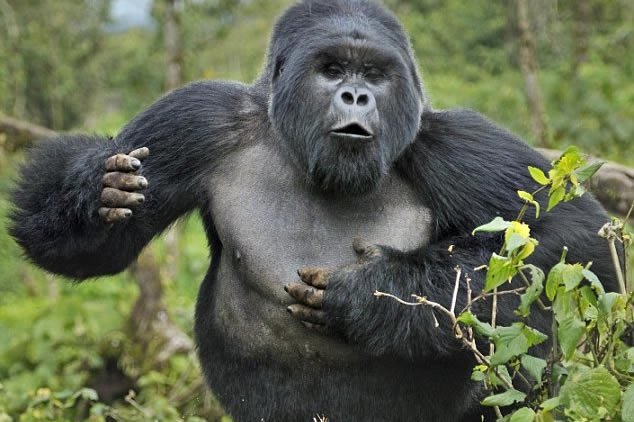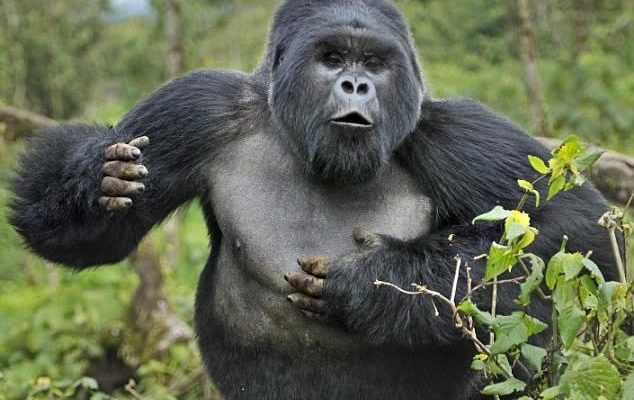
Imagine walking in a serene forest, surrounded by lush greenery. Suddenly, you come across a towering figure. With muscle and power, a Western gorilla stands before you. It’s easy to feel a mixture of awe and fear, right? These animals are capable of incredible strength, and while they generally prefer peace, their instincts can kick in when they feel threatened. Let’s break this down and explore the reality of gorilla behavior and their interactions with humans.
Understanding Gorilla Behavior
Gorillas are highly intelligent creatures with complex social structures. They live in groups called troops, typically led by a dominant male known as a silverback. This leader plays a crucial role in maintaining harmony and protecting the troop. If you’ve ever seen a silverback interact with its troop, you’ll notice they often appear calm and nurturing, especially with youngsters. However, if they sense a threat—be it a rival male or a human getting too close—things can change dramatically.
These mighty primates communicate through a variety of vocalizations, gestures, and facial expressions. They can express fear, aggression, and even playfulness. You might be wondering what prompts this shift in behavior. Well, it often boils down to instinct. When threatened, a gorilla may display aggressive behavior, not out of malice, but to protect themselves or their family.
Incidents of Aggression
While gorillas don’t typically seek out conflict with humans, there have been documented cases of aggression. These incidents often occur when humans encroach upon their territory or when they misinterpret the gorilla’s natural behaviors. In some situations, visitors in nature reserves have accidentally startled a gorilla, leading to a defensive response—usually consisting of chest beating, loud vocalizations, or even charging.
Consider a scenario where a hiker unknowingly gets too close to a silverback with its young. The silverback might perceive this as a threat and react swiftly to drive off what it sees as an intruder. It’s essential to remember that gorillas are wild animals. Their instincts guide their actions, and a defensive response is much more likely when provoked.
How to Safely Interact with Gorillas
If you ever find yourself in an area where Western gorillas roam, it’s vital to respect their space. Here are some tips to keep both you and the gorillas safe:
- Maintain Distance: Always observe gorillas from a safe distance—at least 25 feet away. This gives them room to feel secure.
- Stay Quiet: Loud noises can startle gorillas. Speak softly and keep movements slow to avoid alarming them.
- Follow Guidelines: If you’re in a national park or reserve, adhere to the rules set by guides. They know how to keep both gorillas and visitors safe.
- Never Feed Them: Feeding wild gorillas can disrupt their natural behavior and make them less wary of humans.
By following these basic safety tips, you’ll minimize the chances of negative encounters and help protect these incredible creatures.
Gorillas vs. Other Wildlife
When comparing the Western gorilla’s potential danger to that of other wildlife, you might find some surprising truths. For example, while gorillas can react aggressively, their primary behavior is grounded in peacefulness. Other animals, like lions or crocodiles, are predator species. They actively hunt and pose a direct threat to humans.
In contrast, gorillas typically avoid humans altogether. Their strength is more of a defensive mechanism than an offensive one. They don’t seek out confrontation. Understanding this can help put their potential danger into perspective. You’re far more likely to encounter peril while hiking without proper preparation than to face a gorilla if you respect its space.
The Role of Conservation
Conservation efforts play a significant role in mitigating potential dangers between humans and gorillas. As habitats are threatened by logging and farming, gorillas are pushed closer to human settlements. This not only endangers their population, but it increases the likelihood of negative interactions.
Many organizations work tirelessly to protect gorilla habitats and educate local communities about living in harmony with these magnificent animals. Supporting conservation efforts can lead to healthier ecosystems and can reduce the chances of conflict. By creating a sustainable environment, both humans and gorillas can thrive.
Final Thoughts on Human-Gorilla Interaction
So, can the Western gorilla be dangerous to humans? Yes, but mainly when they feel threatened or cornered. It’s crucial to approach these magnificent creatures with respect and awareness.
While they are capable of great strength and occasional aggression, they are primarily gentle giants with a preference for peace. By taking proper precautions, respecting their space, and supporting conservation initiatives, we can create a world where both humans and gorillas coexist safely. Ultimately, understanding these beautiful animals is the first step toward appreciating and protecting them.

